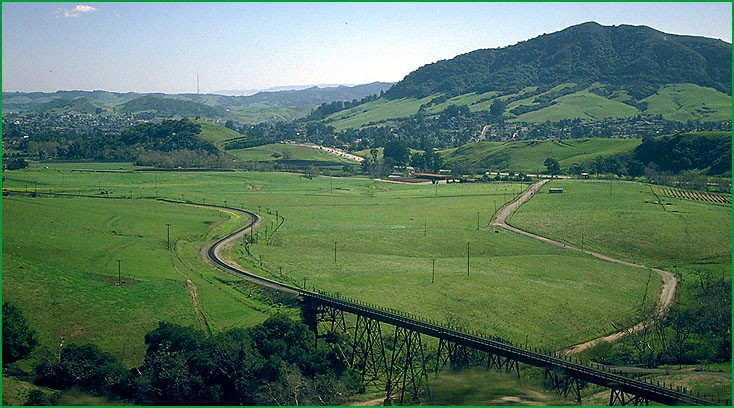 | Subsection k - South Coastal Santa Lucia Range |
San Luis Obispo area Robert Ettner |
http://www.fs.fed.us/r5/projects/ecoregions/261ak.htm
This subsection is the southern part of the Santa Lucia Range that is near the coast, between the Nacimiento fault and the Pacific Ocean. The climate is hot and subhumid; it is modified greatly by marine influence. MLRAs 14c, 14d, and 15d.
Lithology and Stratigraphy. This subsection consists of mostly folded, faulted, and generally metamorphosed sedimentary and volcanic rocks of the Franciscan Complex and much less extensive Cretaceous sediments of the great valley sequence. Some ultramafic rock occurs in this subsection. Miocene marine sediments dominate the southeast end of the subsection, from San Luis Obispo to the Santa Maria or Sisquoc River. Late Quaternary alluvium occurs in Los Osos Valley and some Quaternary marine sediments are along the coast.
Geomorphology. This is a subsection of northwest trending mountains and hills with rounded ridges, steep sides, and mostly narrow canyons. Los Osos Valley is a broad one with substantial areas of floodplain, alluvial fans, and terraces. Remnants of marine terraces are present on narrow benches along the coast. Sand dunes are common along the coast, both adjacent to the beach and on marine terraces. The subsection elevation range is from sea-level up to 3408 feet on Pine Mountain and 3744 feet on Alder Peak at the northwest edge of the subsection. Mass wasting and fluvial erosion are the main geomorphic processes. Sedimentation is an important process in Los Osos Valley. Wind is an important geomorphic agent along the coast.
Soils. The soils are mostly Lithic Xerorthents, Lithic and Pachic Ultic Haploxerolls, serpentinitic Lithic Argixerolls, and Chromic Pelloxererts. Most of these soils are present on Miocene rocks, also, plus shallow Pachic Haploxerolls and Calcic Pachic Haploxerolls at the relatively dry southeast end of the subsection. Pachic Haploxerolls and Chromic Pelloxererts are common on alluvium and marine terraces. Typic and Alfic Xeropsamments prevail in eolian sand behind beaches and on some marine terraces. The soils are well drained, and most are leached free of carbonates, except those on Miocene rocks at the southwest end of the subsection. The soil temperature regimes are thermic. Soil moisture regimes are xeric.
Vegetation. The predominant natural plant communities are Coast live oak series, Chamise series, Manzanita shrublands, and Needlegrass grasslands. Some edaphic associations are Chamise series on shallow soils, Leather oak series on shallow serpentinitic soils, Needlegrass grasslands on Vertisols, and Manzanita shrublands on silicic sandstones. California sagebrush - black sage series is common near the coast and Coast live oak series and Valley oak series are common in Los Osos Valley. The dunes support a succession of plant communities, from bare dune through herbaceous communities and Coyote brush series to California sagebrush - black sage series on stabilized dunes.
Characteristic series by lifeform include:
Dune vegetation: Dune lupine-goldenbrush series, Sand-verbena - beach bursage series, Yellow bush lupine series.
Saltmarsh vegetation: Cordgrass series, Ditchgrass series, Pickleweed series, Saltgrass series, Sedge series.
Grasslands: California annual grassland series, Purple needlegrass series.
Shrublands: Black sage series, Blue blossom series, California encelia series, California sagebrush series, California sagebrush - black sage series, Chamise series, Chamise - bigberry manzanita series, Chamise - black sage series, Chamise - wedgeleaf ceanothus series, Coyote brush series, Deer brush series, Eastwood manzanita series, Leather oak series, Scrub oak series, Wedgeleaf ceanothus series, Woollyleaf manzanita series.
Forests and woodlands: Bishop pine series, California bay series, California sycamore series, Coast live oak series, Knobcone pine series, Mixed oak series, Sargent cypress series, Tanoak series, Valley oak series, White alder series.
Climate. The mean annual precipitation is about 20 to 40 inches. It is practically all rain, except for some snow on at higher elevations. Mean annual temperature is about 50¯ to 60¯ F. The mean freeze-free period is about 250 to 300 days.
Surface Water. Runoff is rapid and all but the larger streams are generally dry during the summer. Streams on the seaward side of the mountains in the northwestern part of the subsection may be perennial. There are no lakes, other than temporary ponding behind dunes
